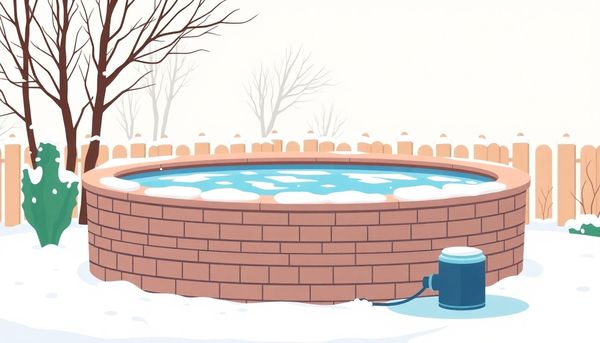Top Pool Cover Pumps for Winter 2025: Protect Your Investment
March 21th, 2024
March 21th, 2024
As autumn leaves begin to blanket the ground and the air turns crisp, thoughts inevitably turn to winter preparations. Among these, ensuring your pool is ready for the colder months often tops the list. A quality pool cover pump can prove indispensable for maintaining your pool during this period. Not only does it prevent water accumulation and debris build-up, but it also helps extend the life of your pool cover, protecting your long-term investment.
Recalling a particularly harsh winter a few years back, I remember the struggle of managing without a reliable pump. Every storm seemed to bring a deluge, leaving pools of water to stagnate atop the cover, threatening to breach and cause damage. A properly chosen pump takes away these worries, acting as a steadfast guardian against winter's worst.
As you begin your search for the perfect pool cover pump for 2024, consider the latest advancements. Manufacturers have introduced models that boast impressive efficiency, durability, and ease of use. Whether you're looking at electric, automatic, or manual options, there's a solution tailored to fit every need and budget. The peace of mind that comes from knowing your pool is well-protected is worth every penny. So, as we explore the top picks for this year, think of this guide as a helpful companion, ready to assist you in making an informed and beneficial decision.

Winter can be a relentless adversary for your pool cover. As snow falls and rain pelts down, the weight of accumulated water and debris can quickly turn a simple cover into a sagging, overburdened liability. Without a pool cover pump, this weight can cause the cover to stretch, tear, or even collapse, letting unwanted elements into your pristine pool. This not only leads to a murky mess awaiting you come spring but also significantly shortens the lifespan of your cover.
A pool cover pump acts as your first line of defense against nature's burdens. It efficiently siphons off excess water, ensuring your cover remains taut and effective throughout the winter. Imagine the peace of mind knowing that you won't have to manually bail out gallons of water or wrestle with a soggy, heavy cover. In my experience, investing in a reliable pump was a game-changer—it transformed winter pool care from a dreaded chore into a straightforward task.
Choosing the right pump involves considering factors like flow rate, ease of use, and whether you prefer a manual or automatic operation. While an automatic pump offers convenience by activating as needed, a manual option can be just as effective with a bit more vigilance. Remember, a sturdy pump not only protects your pool cover but also preserves your pool's cleanliness, saving you time and effort when the warmer months roll around.
Choosing the right pool cover pump is akin to selecting the perfect tool for an intricate craft project—get it right, and you'll save yourself countless hours and potential headaches. Not all pumps are created equal, and each comes with unique features that cater to different needs. Begin by considering the specific challenges your pool cover faces. For instance, if your area is prone to heavy snow, you might lean towards an automatic pump with freeze protection, like the Wayne automatic utility pump. It senses when water has accumulated, efficiently removing it without you having to brave the cold.
However, if you don't mind a bit of manual labor and your budget is tighter, the Little Giant manual pump might be your ally. With its straightforward, no-frills operation, it’s a reliable companion for those willing to keep an eye on their pool cover and manually activate the pump as needed. Just remember, it's crucial not to leave it out in freezing conditions.
When evaluating your options, consider the pump’s flow rate, power cord length, and ease of maintenance. A higher flow rate can be a lifesaver during unexpected rainfalls, while a long power cord ensures flexibility in placement. Regularly cleaning the intake screen can also prevent clogs, ensuring longevity and performance. Investing in the right pump means less time worrying about your pool cover and more time enjoying the peace of mind that comes with knowing your pool is safe from winter’s challenges.
Keeping your pool cover in pristine condition through the winter doesn't have to be a Herculean task. It's all about being smart with the right tools, and a pool cover pump tops the list. With heavy rainfalls or a sudden snowstorm, water can accumulate quickly, leading to significant strain on your pool cover. Imagine waking up to find your once-flat cover sagging under the weight of gallons of water—that's a situation no pool owner wants to face.
Here's where the magic of a pool cover pump comes into play. Unlike the Sisyphean task of manually emptying water, these pumps work efficiently to prevent that dreaded water build-up. Opt for an automatic model and it'll activate itself as soon as water levels rise, ensuring you can stay cozy indoors when the skies open up. For those who prefer to keep things manual, these pumps are still a breeze to use. Simply place the pump, connect your hose, and watch the water disappear.
Choosing the right pump involves a few considerations. Look for a high flow rate to handle unexpected downpours, a durable build to withstand winter's chill, and a power cord long enough to reach any outlet. A reliable pump not only safeguards your pool cover but also trims your maintenance list, giving you more time to enjoy that first splash come spring.
A pool cover is like your pool's trusty armor against winter’s assault. While it stands guard, it’s important to remember it also needs some TLC to do its job effectively. Regular maintenance of your pool cover ensures it remains robust and dependable, preventing unwanted debris or excess water from sneaking into your pool and causing chaos.
Start by keeping a vigilant eye on the weather. After a heavy storm or snowfall, inspect the cover for any accumulated water or debris. This is where a pool cover pump comes in handy. An automatic pump can be a lifesaver, activating itself when water levels peak, while a manual pump requires a bit of your attention but gets the job done effectively too. Regardless of your choice, ensuring your pump operates smoothly is key. Check its parts—like the intake screen—for clogs and clean it regularly to maintain its efficiency.
Beyond water management, remember to gently clear off leaves or twigs after a windy day. Use a soft-bristled broom or a non-abrasive foam tool to avoid damaging the cover. And as winter progresses, keep an eye out for any signs of wear and tear. Early detection can prevent minor issues from becoming costly repairs.
Incorporating these habits into your routine not only extends the life of your pool cover but also spares you from unwelcome surprises come spring. With a little consistent care, your pool will be ready to welcome the sun’s return, clear and clean as the day you covered it.
Selecting the perfect pool cover pump for winter maintenance might seem like a small decision, but it can have a significant impact on your pool’s longevity and your peace of mind. When I first faced the task of winterizing my pool, I was overwhelmed by the sheer variety of pumps available. Yet, understanding a few key features simplified the choice immensely.
One crucial consideration is whether to opt for a manual or automatic pump. If you're like me and prefer minimal intervention, an automatic pump with iSwitch technology is a lifesaver. It activates itself when water reaches a certain level, sparing you from frequent checks. Keep in mind, though, you’ll still need to occasionally verify it's functioning correctly. On the other hand, a manual pump could be perfect for those who don't mind a bit of hands-on work and wish to save some money.
Flow rate is another essential factor. A higher gallons-per-hour (gph) rating removes water more swiftly, which is particularly useful during heavy rainfalls or snow melts. For instance, the Wayne utility pump, with a robust 3,000 gph rate, can handle significant water volumes rapidly. But for a less demanding setup, a pump like the Little Giant, with 550 gph, still offers reliable performance for smaller pools.
Finally, ensure your chosen pump has a long power cord and a reliable warranty. These details might seem trivial, but they guarantee that your pool cover pump will serve efficiently throughout harsh winters, ultimately saving you time and costly repairs.
When it comes to choosing the right pool cover pump for winter maintenance, understanding the essential features is crucial. Not all pumps are created equal, and selecting one with the right specifications can make a significant difference between a hassle-free winter and a spring cleaning nightmare.
Start by considering the pump's flow rate. This determines how quickly water is removed from your pool cover. A higher flow rate means less standing water and reduced stress on the cover. For instance, a pump with a capacity of 3,000 gallons per hour (gph) can swiftly handle heavy rainfalls, whereas a 550 gph model might be more suited for lighter tasks or smaller pools.
Durability is another key aspect. Winter is unforgiving, and your pump needs to withstand freezing temperatures. Look for models with automatic freeze protection to ensure the pump doesn't get damaged if left outside during a cold snap. Additionally, a removable intake screen is invaluable for preventing clogs from leaves and debris, saving you from frequent cleanings.
Lastly, the length of the power cord shouldn’t be overlooked. A 25-foot cord, for example, provides ample reach for most pool setups, eliminating the need for dangerous extension cords or awkwardly positioned outlets.
Whether you’re looking for a set-it-and-forget-it solution with automatic models or a more economical manual option, understanding these features will guide you toward the best pump for your needs, ensuring your pool cover stays intact and your pool remains pristine.
Choosing between a manual and an automatic pool cover pump can feel a bit like deciding between a reliable old friend and a high-tech gadget. Each has its charm and unique advantages, but ultimately, it's about aligning with your lifestyle and preferences.
Manual pumps offer simplicity and control. Think of them as requiring a bit of hands-on attention—when you notice water pooling on your cover, you switch them on. While they don't demand constant vigilance, they do ask you to be aware of the weather and your pool cover's condition. If you enjoy a little routine and don't mind checking on your pool cover occasionally, a manual pump could be perfect. It's like tending to a garden; a little effort regularly can yield great results. Plus, with fewer moving parts and no sensors, manual pumps often boast durability and lower costs, appealing to those who prefer straightforward solutions.
On the flip side, automatic pumps are your set-it-and-forget-it option. Equipped with sensors, they activate as soon as the water level hits a predetermined point, sparing you from the chore of monitoring. This convenience comes with a higher price tag, but it offers peace of mind, especially during stormy nights or busy weeks. If your schedule tends to be hectic or you’d rather not think about your pool cover until spring, an automatic pump is a smart choice. It’s like having a diligent assistant who quietly ensures everything runs smoothly in the background.
Whichever path you choose, both pump types help protect your pool cover and ease winter maintenance. Consider what fits best with your daily rhythm and budget, and you'll make the right choice for your pool's winter care.
There's an art to positioning your pool cover pump just right, and mastering it can make all the difference in winter maintenance. It's akin to finding the sweet spot on a seesaw—you want balance and efficiency. When setting up your pump, remember that the lowest point of the pool cover is your target. This is where water naturally accumulates, forming a makeshift basin of rain, melted snow, and debris. By placing your pump here, you ensure it tackles the bulk of collected water efficiently, reducing strain on the cover and prolonging its life.
Consider the layout of your pool and surrounding area. If there's a natural slope or indentation in your yard, this can affect water flow and collection. A friend once shared how they cleverly used a slight incline in their pool area to their advantage, positioning the pump to move water away seamlessly. Such little tricks can save you from unnecessary hassle.
Additionally, securing the pump in place can prevent it from shifting due to water movement or wind. Utilize any ropes or cords provided with your pump, anchoring it to a sturdy part of the cover or nearby fixtures. This ensures the pump remains stable and continuously effective. Remember, a well-positioned pump not only prevents damage from accumulated water but also makes spring pool opening a breeze.

Winter arrives with its own set of challenges, especially if you own a pool that needs safeguarding from the elements. A pool cover pump is not just a convenience; it’s an essential tool for preserving the integrity of your pool cover throughout the colder months. When ignored, the accumulation of rainwater, snow, and debris can exert enormous pressure on the cover, potentially leading to tears or sagging. I remember a neighbor's cover giving way under the weight of a particularly heavy snowfall, turning spring cleanup into a daunting task.
A well-chosen pool cover pump prevents such disasters by efficiently removing unwanted water and debris build-up. Automatic pumps, equipped with sensors, spring into action as soon as water levels rise, effortlessly keeping your cover free from excess weight. For those who prefer a more hands-on approach, manual pumps also offer reliable service. However, they require periodic checks to ensure timely operation.
While snow itself isn’t directly managed by these pumps, addressing water accumulation before temperatures plummet can help prevent ice formation, which is even harder to manage. Investing in a quality pump not only safeguards your pool cover but also means less hassle when you’re ready to open your pool in the spring. So, whether opting for a manual or automatic model, choosing the right pump is a step towards a stress-free winter and an enjoyable swimming season ahead.
Selecting the ideal pool cover pump involves more than a quick buy; it’s about ensuring your winter sanctuary remains pristine and ready for the thaw. A close friend once lamented about their shattered pool cover after a particularly harsh winter. The culprit? A neglected pool cover overwhelmed by rain and debris. With this in mind, one starts to appreciate the significance of a reliable pump.
Begin by considering the type of pump that matches your lifestyle. Automatic pumps are great for those who prefer set-and-forget convenience. They activate upon detecting water levels, sparing you from constant vigilance. The Wayne automatic utility pump, for example, offers energy efficiency and peace of mind with its iSwitch technology, which efficiently manages water levels without your intervention. But, if keeping things under manual control suits you, the Little Giant manual pump presents a budget-friendly, simple solution, albeit requiring periodic attention.
Pay attention to the pump's flow rate and power cord length. A high flow rate, like the 3,000 gallons per hour offered by some models, ensures swift removal of water, preventing the dreaded mid-winter cover sag. Additionally, a long power cord, at least 25 feet, allows flexibility in positioning, accommodating various pool sizes and layouts.
Lastly, always check for user-friendly features such as debris screens and hose adapters. These make maintenance straightforward, reducing the risk of clogs and prolonging the pump’s life. Choosing the right pump is not just about managing water levels; it’s about safeguarding your pool investment and ensuring effortless spring openings.
Winter can be a challenging season for pool owners, not just for the freezing temperatures but also for the heavy toll they take on the pool cover. A pool cover's primary job is to shield your pool from unwanted debris, but when water accumulates, it can become a giant waterbed, sagging under the weight of rain, snow, and leaves. With the right pool cover pump, however, these issues become far more manageable.
When I first installed my pool, I underestimated the impact of winter weather. One unexpected storm left my cover sagging under a substantial weight of water. That’s when I realized the importance of a reliable pool cover pump. With a device that automatically activates when water levels rise, maintenance becomes effortless. It quietly works its magic, ensuring that water doesn't sit long enough to cause damage.
If automation isn't within your budget, manual pumps also provide a practical solution. While they require more attention, the process is simple enough to integrate into your routine, saving your cover from unnecessary stress. By investing in a good pump, you’re also investing in the longevity of your pool cover, preventing the headache and cost of premature replacements. Ultimately, the peace of mind, knowing your pool cover is protected against winter's wrath, is well worth the investment.
Winter wakes up with a string of snowflakes, each adding weight to your pool cover. Ignoring this delicate white blanket can lead to a hefty problem: accumulated snow. That's where regular snow removal steps into the picture, playing a crucial role in preserving your pool cover's lifespan and functionality. Without it, snow piles up, and when it turns to ice, it poses a serious risk of tearing or collapsing the cover.
Consider the routine task of brushing snow off your car windshield in winter. It's a simple act that saves time and prevents damage. The same principle applies to your pool cover. Invest in a snow removal tool designed specifically for pool covers, with a non-abrasive foam head that won’t scratch or tear. Gently push the snow off to prevent the weight from becoming too much for your cover to bear.
In the past, I've seen neighbors and friends skimp on this essential step, only to find themselves dealing with expensive repairs come spring. This doesn’t have to be your story. With a little diligence and the right tools, maintaining a regular snow-removal schedule can keep your pool cover intact and ready for spring’s unveiling. It's a small commitment with big rewards, ensuring your pool cover stays in top shape, ready to protect your pool through the harshest weather.

Maintaining a pool cover during the long winter months doesn't have to be a daunting task. Think of a pool cover pump as your diligent winter assistant, tirelessly keeping things in order so you don’t have to stress about what’s lurking under the snow. A pool cover pump efficiently clears away the rainwater and melting snow that would otherwise weigh down and potentially damage your cover. With the right pump, you not only preserve your cover's longevity but also prevent a swampy mess when spring arrives.
Choosing between a manual and an automatic pump really depends on how involved you want to be. For those who prefer a more hands-off approach, automatic pumps like the Wayne utility pump come equipped with smart technology that detects water levels and activates itself, ensuring any excess water is removed without constant monitoring. On the other hand, a manual pump might require a bit more vigilance but is a budget-friendly option that still effectively manages standing water if used regularly.
Over the years, I’ve found that investing in a reliable pool cover pump is like having a silent guardian. It saves countless hours of tedious work, allowing me to enjoy the snowfall without worrying about the aftermath. A well-chosen pump spares you from the heavy lifting, literally, and keeps your pool in prime condition, ready for a seamless reopening when the warmer days return.
On a chilly winter morning, you might not think much about your pool until spring rolls around. Yet, neglecting the task of preserving your pool cover can lead to unpleasant surprises. Choosing the right pool cover pump is essential for keeping rain, snow, and debris from wreaking havoc on your cover. The right pump will do more than just remove water; it will extend the life of your cover and save you from costly replacements.
Start by considering whether an automatic or manual pump suits your needs. Automatic pumps are excellent for those who prefer a hands-off approach. These models activate when they sense water, saving you from constant check-ins. If budget constraints guide your decisions, a manual pump might be more appealing. It requires a bit more vigilance, but you’ll enjoy the satisfaction of a job well done without breaking the bank.
Pay attention to the pump's flow rate, which determines how quickly it removes water. For those under heavy rainfall or snow, a high flow rate is crucial. Also, don't overlook features like freeze protection and a long power cord, which add convenience and durability.
A friend once mentioned how their automatic pump saved them during a particularly harsh winter, when unexpected rain and snow threatened to overwhelm their pool cover. By investing in a suitable pool cover pump, you too can ensure your pool emerges from winter unscathed, ready for the sunny days ahead.
Winter can be unforgiving to your pool cover, transforming what should be a protective barrier into a waterlogged, debris-ridden mess. This isn’t just a seasonal inconvenience; it’s a potential disaster waiting to unfold. Without the right preparations, your pool cover could buckle under the cumulative weight of rain, snow, and fallen leaves, leading to damage that might necessitate pricey replacements.
Embracing the power of a pool cover pump is your ticket to prevent such mishaps. This underrated tool efficiently removes excess water and small debris from the cover, prolonging its lifespan and ensuring that come springtime, the cleanup is minimal. For those who dread the thought of consistently checking on their pool cover, automatic pumps—with features like iSwitch technology—are a smart choice. They activate by sensing water presence, operating effortlessly to keep your cover as light as possible.
However, you shouldn’t leave everything to the pump. Address snow promptly, as leaving it to melt can lead to heavier, icy complications. Employ a snow removal tool that’s gentle on your cover to avoid tears and damage. For those on a budget, manual pumps remain a viable option, albeit with more hands-on management. Regular use not only safeguards your cover but also ensures a more seamless transition to pool fun when the warmer weather rolls around. So invest wisely, and let winter’s grip have one less thing to snag.
Winter months can transform a serene backyard pool into a potential burdensome maintenance task. With relentless rain, snow, and leaves, an unprepared pool cover can sag under the weight, eventually letting unwanted debris slip into the water below. This not only leads to costly repairs but also extra hours of cleanup when spring rolls around. The magic solution? A pool cover pump.
Several years ago, I faced this exact dilemma. My pool cover had become a soggy, algae-laden headache. That’s when I discovered the beauty of automation with pool cover pumps. These handy devices, especially the automatic ones, can be lifesavers. Set one up, and it quietly gets to work, detecting when water levels rise and activating to remove excess water seamlessly. For anyone who appreciates hands-off solutions, models like the Wayne automatic pump come highly recommended. With features such as iSwitch technology and automatic freeze protection, they offer peace of mind all winter long.
For those who prefer a more manual approach, options like the Little Giant pump are available. Though it requires a bit more vigilance, it’s a less costly alternative that still efficiently manages standing water. Whether you choose automated convenience or manual reliability, investing in a pool cover pump ensures your pool remains protected, and come spring, you'll be grateful for the foresight.

When facing the challenges of winter pool maintenance, opting for an automatic pool cover pump can be a game-changer. Rather than constantly monitoring and manually clearing water accumulation, an automatic system takes the hassle out of the equation. These pumps are designed to activate as soon as water builds up, preventing the weight from stressing the cover. This proactive solution not only preserves your pool cover but also saves you a substantial amount of time and effort.
Take, for instance, the Wayne automatic pool cover utility pump. Its iSwitch technology senses water levels and activates accordingly, meaning you can spend more time cozy indoors rather than braving the cold outdoors. Imagine waking up after a snowy night to find your pool cover clear of water, thanks to the pump's efficient operation. Its robust mechanism can handle up to 3,000 gallons per hour, swiftly relocating unwanted water.
Another advantage is the automatic freeze protection. During those unpredictable winter days when temperatures drop unexpectedly, this feature ensures that your pump continues to function without sustaining damage. You won't have to worry about costly repairs or replacements, which is a relief when winter's unpredictability strikes. Investing in an automatic pool cover pump provides not just convenience but peace of mind, making winter maintenance a breeze while extending the life of your pool cover.
Choosing the right pool-cover pump can feel like picking the perfect tool from a bustling hardware store—an overwhelming task if you don’t know what you're looking for. Winter’s relentless grip can transform your peaceful pool into a potential disaster zone, with snow, rain, and debris all conspiring to weigh down and damage your cover. Imagine waking up to a pool cover sagging under the weight of gallons of icy water; it’s a situation no pool owner wants to face. Selecting the best pump can save you from this headache.
Start by considering the automatic versus manual debate. If you're the type who enjoys a hands-off approach, automatic pumps are your best bet. They sit on your pool cover, quietly monitoring for water accumulation, ready to spring into action when necessary. With these, you can sip hot cocoa inside while winter storms rage, knowing your pump is working to keep your cover clear.
On the other hand, manual pumps require a bit more attention. They’re perfect for those who don’t mind checking on their pool cover regularly. While they demand more effort, they often come at a friendlier price point and still manage the job effectively when used consistently.
Regardless of your choice, ensure your pump comes with a long power cord for flexibility, a high flow rate to handle heavy rainfall, and a durable build to withstand winter conditions. Investing wisely now means less trouble and more enjoyment next pool season.
Winter can be the ultimate test for any pool cover, challenging its strength and endurance. The relentless weight of snow, rain, and debris can turn a once-pristine cover into a sagging mess. Investing in a reliable pool cover pump is like having a steadfast partner through this seasonal ordeal, ensuring your cover remains in peak condition until the thaw.
Consider the automatic features found in today's pumps, like iSwitch technology, which activate the pump precisely when water levels rise. No more frantic sprints outside during a downpour to switch on the pump manually. The ease of automation, supported by features such as freeze protection, means that even in sub-zero temperatures, your pump stays protected, reducing wear and tear.
Think of a friend who swears by their Little Giant pump. Despite its manual operation, it stands as a testament to reliability and simplicity. It might require a bit of vigilance to manually operate, but its efficiency in handling standing water is commendable. Plus, regular use ensures your pool cover stays light and free of excess weight, extending its lifespan significantly.
Ultimately, choosing the right pool cover pump isn't just about convenience—it's about preserving the longevity of your pool cover. A reliable pump not only saves you from potential headaches but also ensures that when spring arrives, you're not met with a swampy surprise. Embrace this small yet powerful tool, and let it work its magic, safeguarding your pool through winter's harshest days.

This article provided insights into maintaining your pool. Start your pool care journey today!
Want to become a pool maintenance expert? Our free Pool School course covers everything you need to know about pool care. From basic maintenance to advanced troubleshooting, you'll learn how to:
Join over 10,000 pool owners who have already transformed their pool care routine. Get started with our free Pool School course today!